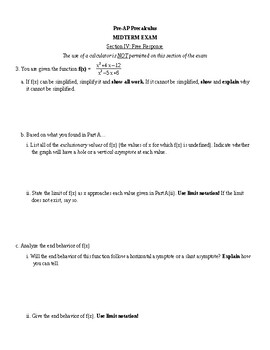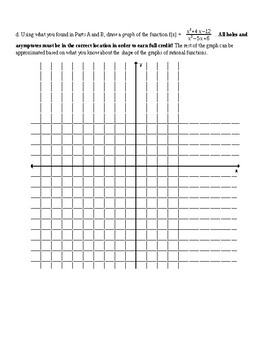Pre-AP Free Response Problems (AP-Style): Exp/Log/Piecewise/Rational
Broderick's Advanced Math Emporium
19 Followers
Grade Levels
10th - 12th
Subjects
Resource Type
Standards
CCSSHSA-APR.D.6
CCSSHSA-CED.A.2
CCSSHSA-CED.A.3
CCSSHSA-REI.A.1
CCSSHSA-REI.A.2
Formats Included
- Word Document File
Pages
6 pages
Broderick's Advanced Math Emporium
19 Followers
Description
Set of 3 Free Response Problems for Algebra II or Precalculus. Modeled after AP Calculus problems with regard to style, rigor, and grading scale. #1 assesses exponential and logarithmic functions (in real-world context), #2 assesses piecewise-defined functions (in real-world context), and #3 assesses rational functions by equation and by graph. Scoring rubrics included. If using as assessment, each question should take about 15 minutes (45 minutes total)
Total Pages
6 pages
Answer Key
Included with rubric
Teaching Duration
45 minutes
Report this resource to TPT
Reported resources will be reviewed by our team. Report this resource to let us know if this resource violates TPT’s content guidelines.
Standards
to see state-specific standards (only available in the US).
CCSSHSA-APR.D.6
Rewrite simple rational expressions in different forms; write 𝘢(𝘹)/𝘣(𝘹) in the form 𝘲(𝘹) + 𝘳(𝘹)/𝘣(𝘹), where 𝘢(𝘹), 𝘣(𝘹), 𝘲(𝘹), and 𝘳(𝘹) are polynomials with the degree of 𝘳(𝘹) less than the degree of 𝘣(𝘹), using inspection, long division, or, for the more complicated examples, a computer algebra system.
CCSSHSA-CED.A.2
Create equations in two or more variables to represent relationships between quantities; graph equations on coordinate axes with labels and scales.
CCSSHSA-CED.A.3
Represent constraints by equations or inequalities, and by systems of equations and/or inequalities, and interpret solutions as viable or non-viable options in a modeling context. For example, represent inequalities describing nutritional and cost constraints on combinations of different foods.
CCSSHSA-REI.A.1
Explain each step in solving a simple equation as following from the equality of numbers asserted at the previous step, starting from the assumption that the original equation has a solution. Construct a viable argument to justify a solution method.
CCSSHSA-REI.A.2
Solve simple rational and radical equations in one variable, and give examples showing how extraneous solutions may arise.





